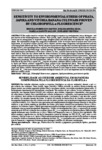Use este identificador para citar ou linkar para este item:
http://biblioteca.incaper.es.gov.br/digital/handle/item/2712Registro completo de metadados
| Campo DC | Valor | Idioma |
|---|---|---|
| dc.contributor.author | PRISCILA NOBRES DOS SANTOS | pt_BR |
| dc.contributor.author | DIOLINA MOURA SILVA | pt_BR |
| dc.contributor.author | CAMILLA ZANOTTI GALLON | pt_BR |
| dc.contributor.author | JOSÉ AIRES VENTURA | pt_BR |
| dc.date.accessioned | 2017-06-20T18:40:24Z | - |
| dc.date.available | 2017-06-20T18:40:24Z | - |
| dc.date.created | 2017 | pt_BR |
| dc.date.issued | 2017-06-20 | pt_BR |
| dc.identifier.other | 16274 | pt_BR |
| dc.identifier.uri | http://biblioteca.incaper.es.gov.br/digital/handle/item/2712 | - |
| dc.description | This study aimed to evaluate the physiological responses to environmental stress during pre- and post-harvest of the following banana cultivars: Prata (AAB), Japira (AAAB) and Vitoria (AAAB). Analyses were carried out on young plants at vegetative stage (daughter-plant) and adult plants at reproductive stage (motherplant). The experimental design was completely randomized. In the in vivo pre-harvest analysis were used seven replications, in a factorial scheme (3x2x2), three cultivars and two stages (vegetative and reproductive) and two collection periods (March and June). For the analysis of post-harvest quality were used five replications in a factorial design (3x2x5), corresponding to three cultivars, two development stages and five periods of post-harvest analysis, carried out every two days from stage 4 of fruit ripening. The chlorophyll a fluorescence emission kinetics showed low photochemical performance of the three cultivars in June, a period characterized by lower temperatures and water deficit. Prata was the cultivar with the lowest tolerance to abiotic physiological behavior changes, which also reflected in fruit quality, because there was a change in physical and physicochemical parameters. Japira and Vitoria cultivars showed similar physiological responses in the pre- and post-harvest periods, according to their phylogenetic proximity. The total performance index, i.e., the conservation of energy absorbed by PSII up to the reduction of the final PSI acceptors (PItotal) and the di-malonic aldehyde (MDA) content were significantly higher in Japira and Vitoria cultivars compared to Prata cultivar in the reproductive phase. There was no significant change in the potential quantum efficiency of PSII (FV / FM = jP0) among the three cultivars. It was concluded that Japira and Vitoria cultivars showed greater plasticity to tolerate or even adapt to abiotic variations keeping higher fruit yield. PItotal is the most sensitive parameter during the banana life cycle and important tool for distinguishing different cultivars yields. | pt_BR |
| dc.language | en | pt_BR |
| dc.publisher | Revista Brasileira de Fruticultura, Jaboticabal, v. 39, n. 2, e-911, 2017. | pt_BR |
| dc.subject | Musa spp | pt_BR |
| dc.subject | Fluorescência da clorofila | pt_BR |
| dc.subject | Pigmentos | pt_BR |
| dc.subject | Peroxidação lipídica | pt_BR |
| dc.subject | Qualidade pós-colheita | pt_BR |
| dc.title | Sensitivity to environmental stress of prata, Japira and Vitória banana cultivars proven by chlorophyll a fluorescence. | pt_BR |
| dc.type | -- | pt_BR |
| dc.ainfo.id | 15411 | pt_BR |
| dc.ainfo.lastupdate | 2017-06-20 | pt_BR |
| dc.ainfo.depositante | Catia Ribeiro Barcelos | pt_BR |
| dc.subject.nalthesaurus | Musa spp. | pt_BR |
| dc.subject.nalthesaurus | Chlorophyll fluorescence | pt_BR |
| dc.subject.nalthesaurus | Pigments | pt_BR |
| dc.subject.nalthesaurus | Lipid peroxidation | pt_BR |
| dc.subject.nalthesaurus | Post-harvest quality | pt_BR |
| dc.identifier.doi | http://dx.doi.org/10.1590/0100-29452017991 | pt_BR |
| Aparece nas coleções: | Memória Técnica do Incaper  | |
Arquivos associados a este item:
| Arquivo | Descrição | Tamanho | Formato | |
|---|---|---|---|---|
| BRT-Sensitivity-to-environmental-Aires-Ventura.pdf | 1,62 MB | Adobe PDF |  Visualizar/Abrir |
Os itens no repositório estão protegidos por copyright, com todos os direitos reservados, salvo quando é indicado o contrário.
